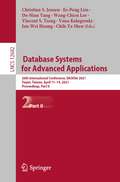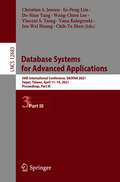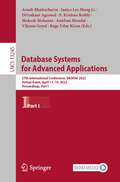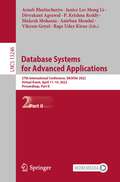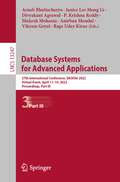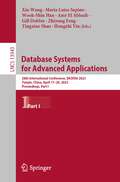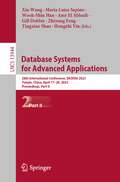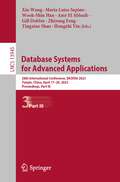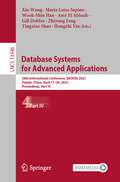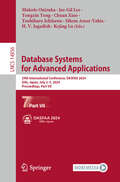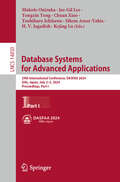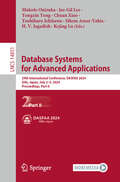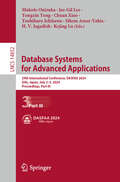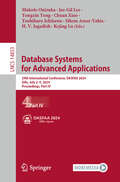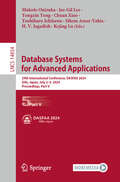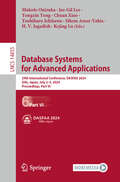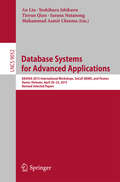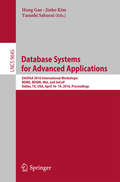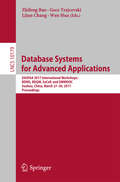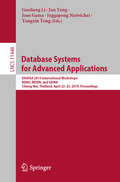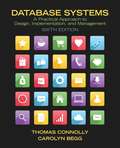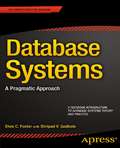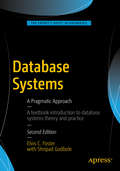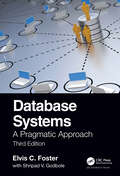- Table View
- List View
Database Systems for Advanced Applications: 26th International Conference, DASFAA 2021, Taipei, Taiwan, April 11–14, 2021, Proceedings, Part I (Lecture Notes in Computer Science #12681)
by Ee-Peng Lim Vincent S. Tseng Christian S. Jensen De-Nian Yang Jen-Wei Huang Chih-Ya Shen Wang-Chien Lee Vana KalogerakiThe three-volume set LNCS 12681-12683 constitutes the proceedings of the 26th International Conference on Database Systems for Advanced Applications, DASFAA 2021, held in Taipei, Taiwan, in April 2021. The total of 156 papers presented in this three-volume set was carefully reviewed and selected from 490 submissions. The topic areas for the selected papers include information retrieval, search and recommendation techniques; RDF, knowledge graphs, semantic web, and knowledge management; and spatial, temporal, sequence, and streaming data management, while the dominant keywords are network, recommendation, graph, learning, and model. These topic areas and keywords shed the light on the direction where the research in DASFAA is moving towards. Due to the Corona pandemic this event was held virtually.
Database Systems for Advanced Applications: 26th International Conference, DASFAA 2021, Taipei, Taiwan, April 11–14, 2021, Proceedings, Part II (Lecture Notes in Computer Science #12682)
by Ee-Peng Lim Vincent S. Tseng Christian S. Jensen De-Nian Yang Jen-Wei Huang Chih-Ya Shen Wang-Chien Lee Vana KalogerakiThe three-volume set LNCS 12681-12683 constitutes the proceedings of the 26th International Conference on Database Systems for Advanced Applications, DASFAA 2021, held in Taipei, Taiwan, in April 2021. The total of 156 papers presented in this three-volume set was carefully reviewed and selected from 490 submissions. The topic areas for the selected papers include information retrieval, search and recommendation techniques; RDF, knowledge graphs, semantic web, and knowledge management; and spatial, temporal, sequence, and streaming data management, while the dominant keywords are network, recommendation, graph, learning, and model. These topic areas and keywords shed the light on the direction where the research in DASFAA is moving towards. Due to the Corona pandemic this event was held virtually.
Database Systems for Advanced Applications: 26th International Conference, DASFAA 2021, Taipei, Taiwan, April 11–14, 2021, Proceedings, Part III (Lecture Notes in Computer Science #12683)
by Ee-Peng Lim Vincent S. Tseng Christian S. Jensen De-Nian Yang Jen-Wei Huang Chih-Ya Shen Wang-Chien Lee Vana KalogerakiThe three-volume set LNCS 12681-12683 constitutes the proceedings of the 26th International Conference on Database Systems for Advanced Applications, DASFAA 2021, held in Taipei, Taiwan, in April 2021. The total of 156 papers presented in this three-volume set was carefully reviewed and selected from 490 submissions. The topic areas for the selected papers include information retrieval, search and recommendation techniques; RDF, knowledge graphs, semantic web, and knowledge management; and spatial, temporal, sequence, and streaming data management, while the dominant keywords are network, recommendation, graph, learning, and model. These topic areas and keywords shed the light on the direction where the research in DASFAA is moving towards. Due to the Corona pandemic this event was held virtually.
Database Systems for Advanced Applications: 27th International Conference, DASFAA 2022, Virtual Event, April 11–14, 2022, Proceedings, Part I (Lecture Notes in Computer Science #13245)
by Mukesh Mohania P. Krishna Reddy Anirban Mondal Arnab Bhattacharya Vikram Goyal Janice Lee Mong Li Divyakant Agrawal Rage Uday KiranThe three-volume set LNCS 13245, 13246 and 13247 constitutes the proceedings of the 26th International Conference on Database Systems for Advanced Applications, DASFAA 2022, held online, in April 2021. The total of 72 full papers, along with 76 short papers, are presented in this three-volume set was carefully reviewed and selected from 543 submissions. Additionally, 13 industrial papers, 9 demo papers and 2 PhD consortium papers are included. The conference was planned to take place in Hyderabad, India, but it was held virtually due to the COVID-19 pandemic.
Database Systems for Advanced Applications: 27th International Conference, DASFAA 2022, Virtual Event, April 11–14, 2022, Proceedings, Part II (Lecture Notes in Computer Science #13246)
by Mukesh Mohania P. Krishna Reddy Anirban Mondal Arnab Bhattacharya Vikram Goyal Janice Lee Mong Li Divyakant Agrawal Rage Uday KiranThe three-volume set LNCS 13245, 13246 and 13247 constitutes the proceedings of the 26th International Conference on Database Systems for Advanced Applications, DASFAA 2022, held online, in April 2021. The total of 72 full papers, along with 76 short papers, are presented in this three-volume set was carefully reviewed and selected from 543 submissions. Additionally, 13 industrial papers, 9 demo papers and 2 PhD consortium papers are included. The conference was planned to take place in Hyderabad, India, but it was held virtually due to the COVID-19 pandemic.
Database Systems for Advanced Applications: 27th International Conference, DASFAA 2022, Virtual Event, April 11–14, 2022, Proceedings, Part III (Lecture Notes in Computer Science #13247)
by Mukesh Mohania P. Krishna Reddy Anirban Mondal Arnab Bhattacharya Vikram Goyal Janice Lee Mong Li Divyakant Agrawal Rage Uday KiranThe three-volume set LNCS 13245, 13246 and 13247 constitutes the proceedings of the 26th International Conference on Database Systems for Advanced Applications, DASFAA 2022, held online, in April 2021. The total of 72 full papers, along with 76 short papers, are presented in this three-volume set was carefully reviewed and selected from 543 submissions. Additionally, 13 industrial papers, 9 demo papers and 2 PhD consortium papers are included. The conference was planned to take place in Hyderabad, India, but it was held virtually due to the COVID-19 pandemic.
Database Systems for Advanced Applications: 28th International Conference, DASFAA 2023, Tianjin, China, April 17–20, 2023, Proceedings, Part I (Lecture Notes in Computer Science #13943)
by Xin Wang Hongzhi Yin Zhiyong Feng Wook-Shin Han Gill Dobbie Amr El Abbadi Maria Luisa Sapino Yingxiao ShaoThe four-volume set LNCS 13943, 13944, 13945 and 13946 constitutes the proceedings of the 28th International Conference on Database Systems for Advanced Applications, DASFAA 2023, held in April 2023 in Tianjin, China.The total of 125 full papers, along with 66 short papers, are presented together in this four-volume set was carefully reviewed and selected from 652 submissions. Additionally, 15 industrial papers, 15 demo papers and 4 PhD consortium papers are included. The conference presents papers on subjects such as model, graph, learning, performance, knowledge, time, recommendation, representation, attention, prediction, and network.
Database Systems for Advanced Applications: 28th International Conference, DASFAA 2023, Tianjin, China, April 17–20, 2023, Proceedings, Part II (Lecture Notes in Computer Science #13944)
by Xin Wang Hongzhi Yin Zhiyong Feng Wook-Shin Han Gill Dobbie Amr El Abbadi Maria Luisa Sapino Yingxiao ShaoThe four-volume set LNCS 13943, 13944, 13945 and 13946 constitutes the proceedings of the 28th International Conference on Database Systems for Advanced Applications, DASFAA 2023, held in April 2023 in Tianjin, China.The total of 125 full papers, along with 66 short papers, are presented together in this four-volume set was carefully reviewed and selected from 652 submissions. Additionally, 15 industrial papers, 15 demo papers and 4 PhD consortium papers are included. The conference presents papers on subjects such as model, graph, learning, performance, knowledge, time, recommendation, representation, attention, prediction, and network.
Database Systems for Advanced Applications: 28th International Conference, DASFAA 2023, Tianjin, China, April 17–20, 2023, Proceedings, Part III (Lecture Notes in Computer Science #13945)
by Xin Wang Hongzhi Yin Zhiyong Feng Wook-Shin Han Gill Dobbie Amr El Abbadi Maria Luisa Sapino Yingxiao ShaoThe four-volume set LNCS 13943, 13944, 13945 and 13946 constitutes the proceedings of the 28th International Conference on Database Systems for Advanced Applications, DASFAA 2023, held in April 2023 in Tianjin, China.The total of 125 full papers, along with 66 short papers, are presented together in this four-volume set was carefully reviewed and selected from 652 submissions. Additionally, 15 industrial papers, 15 demo papers and 4 PhD consortium papers are included. The conference presents papers on subjects such as model, graph, learning, performance, knowledge, time, recommendation, representation, attention, prediction, and network.
Database Systems for Advanced Applications: 28th International Conference, DASFAA 2023, Tianjin, China, April 17–20, 2023, Proceedings, Part IV (Lecture Notes in Computer Science #13946)
by Xin Wang Hongzhi Yin Zhiyong Feng Wook-Shin Han Gill Dobbie Amr El Abbadi Maria Luisa Sapino Yingxiao ShaoThe four-volume set LNCS 13943, 13944, 13945 and 13946 constitutes the proceedings of the 28th International Conference on Database Systems for Advanced Applications, DASFAA 2023, held in April 2023 in Tianjin, China.The total of 125 full papers, along with 66 short papers, are presented together in this four-volume set was carefully reviewed and selected from 652 submissions. Additionally, 15 industrial papers, 15 demo papers and 4 PhD consortium papers are included. The conference presents papers on subjects such as model, graph, learning, performance, knowledge, time, recommendation, representation, attention, prediction, and network.
Database Systems for Advanced Applications: 29th International Conference, DASFAA 2024, Gifu, Japan, July 2-5, 2024, Proceedings, Part VII (Lecture Notes in Computer Science #14856)
by Yoshiharu Ishikawa Yongxin Tong Jae-Gil Lee Chuan Xiao Sihem Amer-Yahia Makoto Onizuka H. V. Jagadish Kejing LuThe seven-volume set LNCS 14850-14856 constitutes the proceedings of the 29th International Conference on Database Systems for Advanced Applications, DASFAA 2024, held in Gifu, Japan, in July 2024. The total of 147 full papers, along with 85 short papers, presented together in this seven-volume set was carefully reviewed and selected from 722 submissions. Additionally, 14 industrial papers, 18 demo papers and 6 tutorials are included. The conference presents papers on subjects such as: Part I: Spatial and temporal data; database core technology; federated learning. Part II: Machine learning; text processing. Part III: Recommendation; multi-media. Part IV: Privacy and security; knowledge base and graphs. Part V: Natural language processing; large language model; time series and stream data. Part VI: Graph and network; hardware acceleration. Part VII: Emerging application; industry papers; demo papers.
Database Systems for Advanced Applications: 29th International Conference, DASFAA 2024, Gifu, Japan, July 2–5, 2024, Proceedings, Part I (Lecture Notes in Computer Science #14850)
by Yoshiharu Ishikawa Yongxin Tong Jae-Gil Lee Chuan Xiao Sihem Amer-Yahia Makoto Onizuka H. V. Jagadish Kejing LuThe seven-volume set LNCS 14850-14856 constitutes the proceedings of the 29th International Conference on Database Systems for Advanced Applications, DASFAA 2024, held in Gifu, Japan, in July 2024. The total of 147 full papers, along with 85 short papers, presented together in this seven-volume set was carefully reviewed and selected from 722 submissions. Additionally, 14 industrial papers, 18 demo papers and 6 tutorials are included. The conference presents papers on subjects such as: Part I: Spatial and temporal data; database core technology; federated learning. Part II: Machine learning; text processing. Part III: Recommendation; multi-media. Part IV: Privacy and security; knowledge base and graphs. Part V: Natural language processing; large language model; time series and stream data. Part VI: Graph and network; hardware acceleration. Part VII: Emerging application; industry papers; demo papers.
Database Systems for Advanced Applications: 29th International Conference, DASFAA 2024, Gifu, Japan, July 2–5, 2024, Proceedings, Part II (Lecture Notes in Computer Science #14851)
by Yoshiharu Ishikawa Yongxin Tong Jae-Gil Lee Chuan Xiao Sihem Amer-Yahia Makoto Onizuka H. V. Jagadish Kejing LuThe seven-volume set LNCS 14850-14856 constitutes the proceedings of the 29th International Conference on Database Systems for Advanced Applications, DASFAA 2024, held in Gifu, Japan, in July 2024. The total of 147 full papers, along with 85 short papers, presented together in this seven-volume set was carefully reviewed and selected from 722 submissions. Additionally, 14 industrial papers, 18 demo papers and 6 tutorials are included. The conference presents papers on subjects such as: Part I: Spatial and temporal data; database core technology; federated learning. Part II: Machine learning; text processing. Part III: Recommendation; multi-media. Part IV: Privacy and security; knowledge base and graphs. Part V: Natural language processing; large language model; time series and stream data. Part VI: Graph and network; hardware acceleration. Part VII: Emerging application; industry papers; demo papers.
Database Systems for Advanced Applications: 29th International Conference, DASFAA 2024, Gifu, Japan, July 2–5, 2024, Proceedings, Part III (Lecture Notes in Computer Science #14852)
by Yoshiharu Ishikawa Yongxin Tong Jae-Gil Lee Chuan Xiao Sihem Amer-Yahia Makoto Onizuka H. V. Jagadish Kejing LuThe seven-volume set LNCS 14850-14856 constitutes the proceedings of the 29th International Conference on Database Systems for Advanced Applications, DASFAA 2024, held in Gifu, Japan, in July 2024. The total of 147 full papers, along with 85 short papers, presented together in this seven-volume set was carefully reviewed and selected from 722 submissions. Additionally, 14 industrial papers, 18 demo papers and 6 tutorials are included. The conference presents papers on subjects such as: Part I: Spatial and temporal data; database core technology; federated learning. Part II: Machine learning; text processing. Part III: Recommendation; multi-media. Part IV: Privacy and security; knowledge base and graphs. Part V: Natural language processing; large language model; time series and stream data. Part VI: Graph and network; hardware acceleration. Part VII: Emerging application; industry papers; demo papers.
Database Systems for Advanced Applications: 29th International Conference, DASFAA 2024, Gifu, Japan, July 2–5, 2024, Proceedings, Part IV (Lecture Notes in Computer Science #14853)
by Yoshiharu Ishikawa Yongxin Tong Jae-Gil Lee Chuan Xiao Sihem Amer-Yahia Makoto Onizuka H. V. Jagadish Kejing LuThe seven-volume set LNCS 14850-14856 constitutes the proceedings of the 29th International Conference on Database Systems for Advanced Applications, DASFAA 2024, held in Gifu, Japan, in July 2024. The total of 147 full papers, along with 85 short papers, presented together in this seven-volume set was carefully reviewed and selected from 722 submissions. Additionally, 14 industrial papers, 18 demo papers and 6 tutorials are included. The conference presents papers on subjects such as: Part I: Spatial and temporal data; database core technology; federated learning. Part II: Machine learning; text processing. Part III: Recommendation; multi-media. Part IV: Privacy and security; knowledge base and graphs. Part V: Natural language processing; large language model; time series and stream data. Part VI: Graph and network; hardware acceleration. Part VII: Emerging application; industry papers; demo papers.
Database Systems for Advanced Applications: 29th International Conference, DASFAA 2024, Gifu, Japan, July 2–5, 2024, Proceedings, Part V (Lecture Notes in Computer Science #14854)
by Yoshiharu Ishikawa Yongxin Tong Jae-Gil Lee Chuan Xiao Sihem Amer-Yahia Makoto Onizuka H. V. Jagadish Kejing LuThe seven-volume set LNCS 14850-14856 constitutes the proceedings of the 29th International Conference on Database Systems for Advanced Applications, DASFAA 2024, held in Gifu, Japan, in July 2024. The total of 147 full papers, along with 85 short papers, presented together in this seven-volume set was carefully reviewed and selected from 722 submissions. Additionally, 14 industrial papers, 18 demo papers and 6 tutorials are included. The conference presents papers on subjects such as: Part I: Spatial and temporal data; database core technology; federated learning. Part II: Machine learning; text processing. Part III: Recommendation; multi-media. Part IV: Privacy and security; knowledge base and graphs. Part V: Natural language processing; large language model; time series and stream data. Part VI: Graph and network; hardware acceleration. Part VII: Emerging application; industry papers; demo papers.
Database Systems for Advanced Applications: 29th International Conference, DASFAA 2024, Gifu, Japan, July 2–5, 2024, Proceedings, Part VI (Lecture Notes in Computer Science #14855)
by Yoshiharu Ishikawa Yongxin Tong Jae-Gil Lee Chuan Xiao Sihem Amer-Yahia Makoto Onizuka H. V. Jagadish Kejing LuThe seven-volume set LNCS 14850-14856 constitutes the proceedings of the 29th International Conference on Database Systems for Advanced Applications, DASFAA 2024, held in Gifu, Japan, in July 2024. The total of 147 full papers, along with 85 short papers, presented together in this seven-volume set was carefully reviewed and selected from 722 submissions. Additionally, 14 industrial papers, 18 demo papers and 6 tutorials are included. The conference presents papers on subjects such as: Part I: Spatial and temporal data; database core technology; federated learning. Part II: Machine learning; text processing. Part III: Recommendation; multi-media. Part IV: Privacy and security; knowledge base and graphs. Part V: Natural language processing; large language model; time series and stream data. Part VI: Graph and network; hardware acceleration. Part VII: Emerging application; industry papers; demo papers.
Database Systems for Advanced Applications: DASFAA 2015 International Workshops, SeCoP, BDMS, and Posters, Hanoi, Vietnam, April 20-23, 2015, Revised Selected Papers (Lecture Notes in Computer Science #9052)
by An Liu Yoshiharu Ishikawa Tieyun Qian Sarana Nutanong Muhammad Aamir CheemaDASFAA is an annual international database conference, located in the Asia-Pacific region,which show cases state-of-the-art R & D activities in databases-terms and their applications. It provides a forum for technical presentations and discussions among database researchers, developers and users from academia, business and industry. DASFAA 2015 the 20th in the series, was held during April 20-23, 2015 in Hanoi, Vietnam. In this year, we carefully selected two workshops, each focusing on specific research issues that contribute to the main themes of the DASFAA conference. This volume contains the final versions of papers accepted for the two workshops: Second International Workshop on Semantic Computing and Personalization (SeCoP 2015); Second International Workshop on Big Data Management and Service (BDMS 2015); and a Poster Session. [All the workshops were selected via a public call-for-proposals process. The workshop organizers put a tremendous amount of effort into soliciting and - lecting papers with a balance of high quality, new ideas and new applications. We asked all workshops to follow a rigid paper selection process, including the procedure to ensure that any Program Committee members are excluded from the paper review process of any paper they are involved with. A requirement about the overall paper acceptance rate of no more than 50% was also imposed on all the workshops. ]
Database Systems for Advanced Applications: DASFAA 2016 International Workshops: BDMS, BDQM, MoI, and SeCoP, Dallas, TX, USA, April 16-19, 2016, Proceedings (Lecture Notes in Computer Science #9645)
by Jinho Kim Hong Gao Yasushi SakuraiThis book constitutes the workshop proceedings of the 21st International Conference on Database Systems for Advanced Applications, DASFAA 2016, held in Dallas, TX, USA, in April 2016. The volume contains 32 full papers (selected from 43 submissions) from 4 workshops, each focusing on a specific area that contributes to the main themes of DASFAA 2016: The Third International Workshop on Semantic Computing and Personalization, SeCoP 2016; the Third International Workshop on Big Data Management and Service, BDMS 2016; the First International Workshop on Big Data Quality Management, BDQM 2016; and the Second International Workshop on Mobile of Internet, MoI 2016.
Database Systems for Advanced Applications: DASFAA 2017 International Workshops: BDMS, BDQM, SeCoP, and DMMOOC, Suzhou, China, March 27-30, 2017, Proceedings (Lecture Notes in Computer Science #10179)
by Wen Hua Lijun Chang Zhifeng Bao Goce TrajcevskiThis two volume set LNCS 10177 and 10178 constitutes the refereed proceedings of the 22nd International Conference on Database Systems for Advanced Applications, DASFAA 2017, held in Suzhou, China, in March 2017. The 73 full papers, 9 industry papers, 4 demo papers and 3 tutorials were carefully selected from a total of 300 submissions. The papers are organized around the following topics: semantic web and knowledge management; indexing and distributed systems; network embedding; trajectory and time series data processing; data mining; query processing and optimization; text mining; recommendation; security, privacy, senor and cloud; social network analytics; map matching and spatial keywords; query processing and optimization; search and information retrieval; string and sequence processing; stream date processing; graph and network data processing; spatial databases; real time data processing; big data; social networks and graphs.
Database Systems for Advanced Applications: DASFAA 2019 International Workshops: BDMS, BDQM, and GDMA, Chiang Mai, Thailand, April 22–25, 2019, Proceedings (Lecture Notes in Computer Science #11448)
by Jun Yang Yongxin Tong Guoliang Li Joao Gama Juggapong NatwichaiThis book constitutes the workshop proceedings of the 24th International Conference on Database Systems for Advanced Applications, DASFAA 2019, held in Chiang Mai, Thailand, in April 2019. The 14 full papers presented were carefully selected and reviewed from 26 submissions to the three following workshops: the 6th International Workshop on Big Data Management and Service, BDMS 2019; the 4th International Workshop on Big Data Quality Management, BDQM 2019; and the Third International Workshop on Graph Data Management and Analysis, GDMA 2019. This volume also includes the short papers, demo papers, and tutorial papers of the main conference DASFAA 2019.
Database Systems: A Practical Approach to Design, Implementation, and Management (6th Edition)
by Thomas Connolly Carolyn BeggDatabase Systems is ideal for a one- or two-term course in database management or database design in an undergraduate or graduate level course. With its comprehensive coverage, this book can also be used as a reference for IT professionals. This best-selling text introduces the theory behind databases in a concise yet comprehensive manner, providing database design methodology that can be used by both technical and non-technical readers. The methodology for relational Database Management Systems is presented in simple, step-by-step instructions in conjunction with a realistic worked example using three explicit phases--conceptual, logical, and physical database design. #65533; Teaching and Learning Experience This program presents a better teaching and learning experience-for you and your students. It provides: Database Design Methodology that can be Used by Both Technical and Non-technical Readers A Comprehensive Introduction to the Theory behind Databases A Clear Presentation that Supports Learning
Database Systems: A Pragmatic Approach
by Elvis C. Foster Shripad V. GodboleDatabase Systems: A Pragmatic Approach provides a comprehensive, yet concise introduction to database systems. It discusses the database as an essential component of a software system, as well as a valuable, mission critical corporate resource. The book is based on lecture notes that have been tested and proven over several years, with outstanding results. It also exemplifies mastery of the technique of combining and balancing theory with practice, to give students their best chance at success. Upholding his aim for brevity, comprehensive coverage, and relevance, author Elvis C. Foster's practical and methodical discussion style gets straight to the salient issues, and avoids unnecessary fluff as well as an overkill of theoretical calculations. The book discusses concepts, principles, design, implementation, and management issues of databases. Each chapter is organized systematically into brief, reader-friendly sections, with itemization of the important points to be remembered. It adopts a methodical and pragmatic approach to solving database systems problems. Diagrams and illustrations also sum up the salient points to enhance learning. Additionally, the book includes a number of Foster's original methodologies that add clarity and creativity to the database modeling and design experience while making a novel contribution to the discipline. Everything combines to make Database Systems: A Pragmatic Approach an excellent textbook for students, and an excellent resource on theory for the practitioner.
Database Systems: A Pragmatic Approach
by Elvis C. Foster Shripad GodboleDatabase Systems: A Pragmatic Approach is a classroom textbook for use by students who are learning about relational databases, and the professors who teach them. It discusses the database as an essential component of a software system, as well as a valuable, mission critical corporate resource. The book is based on lecture notes that have been tested and proven over several years, with outstanding results. It also exemplifies mastery of the technique of combining and balancing theory with practice, to give students their best chance at success. Upholding his aim for brevity, comprehensive coverage, and relevance, author Elvis C. Foster''s practical and methodical discussion style gets straight to the salient issues, and avoids unnecessary fluff as well as an overkill of theoretical calculations. The book discusses concepts, principles, design, implementation, and management issues of databases. Each chapter is organized systematically into brief, reader-friendly sections, with itemization of the important points to be remembered. It adopts a methodical and pragmatic approach to solving database systems problems. Diagrams and illustrations also sum up the salient points to enhance learning. Additionally, the book includes a number of Foster''s original methodologies that add clarity and creativity to the database modeling and design experience while making a novel contribution to the discipline. Everything combines to make Database Systems: A Pragmatic Approach an excellent textbook for students, and an excellent resource on theory for the practitioner. What you''ll learn Learn the relational model and the advantages it brings to software systems Design database schemas with integrity rules that ensure correctness of corporate data Query data using SQL in order to generate reports, charts, graphs, and other business results Learn what it means to be a database administrator, and why the profession is highly paid Become familiar with the common database brands, their similarities and distinctives Explore special topics such as tree-based data, hashing for fast access, distributed and object databases, and more Who this book is for Database Systems: A Pragmatic Approach is aimed at students who are studying database technology, who aspire to a career as a database administrator or designer. The book is particularly useful for professors teaching such students, and who are in need of an affordable textbook. Practicing database administrators and developers wanting to strengthen their theoretical grounding in their discipline may also find the book useful. Table of Contents Part I: Preliminary Topics 1. Introduction to Database Systems 2. The Database System Environment Part II: The Relational Database Model 3. The Relational Model 4. Integrity Rules and Normalization 5. Database Modeling and Design 6. Database User Interface Design 7. Relational Algebra 8. Relational Calculus 9. Relational System a Closer Look Part III: Structured Query Language 10. Overview of SQL 11. SQL Definition Statements 12. SQL Data Manipulation Statements 13. Logical Views and Security 14. The System Catalog 15. Some Limitations of SQL Part IV: Some Commonly Used DBMS Suites 16. Overview of Oracle 17. Overview of DB2 18. Overview of Microsoft SQL Server 19. Overview of Gupta Team Developer and MySQL 20. Overview of Borland Delphi Part V: Advanced Topics 21. Database Administration 22. Distributed Database Systems 23. Object Databases 24. Data Warehousing and Information Extraction 25. Web-Accessible Databases Part VI: Final Preparations 26. Sample Exercises and Examination Questions Part VII: Appendices A. Review of Trees B. Review of Hashing C. Review of Information Gathering Techniques
Database Systems: A Pragmatic Approach, 3rd edition
by Elvis C. Foster Shripad V. GodboleThis book provides a concise but comprehensive guide to the disciplines of database design, construction, implementation, and management. Based on the authors’ professional experience in the software engineering and IT industries before making a career switch to academia, the text stresses sound database design as a necessary precursor to successful development and administration of database systems. The discipline of database systems design and management is discussed within the context of the bigger picture of software engineering. Students are led to understand from the outset of the text that a database is a critical component of a software infrastructure, and that proper database design and management is integral to the success of a software system. Additionally, students are led to appreciate the huge value of a properly designed database to the success of a business enterprise. The text was written for three target audiences. It is suited for undergraduate students of computer science and related disciplines who are pursuing a course in database systems, graduate students who are pursuing an introductory course to database, and practicing software engineers and information technology (IT) professionals who need a quick reference on database design. Database Systems: A Pragmatic Approach, 3rd Edition discusses concepts, principles, design, implementation, and management issues related to database systems. Each chapter is organized into brief, reader-friendly, conversational sections with itemization of salient points to be remembered. This pragmatic approach includes adequate treatment of database theory and practice based on strategies that have been tested, proven, and refined over several years. Features of the third edition include: Short paragraphs that express the salient aspects of each subject Bullet points itemizing important points for easy memorization Fully revised and updated diagrams and figures to illustrate concepts to enhance the student’s understanding Real-world examples Original methodologies applicable to database design Step-by-step, student-friendly guidelines for solving generic database systems problems Opening chapter overviews and concluding chapter summaries Discussion of DBMS alternatives such as the Entity–Attributes–Value model, NoSQL databases, database-supporting frameworks, and other burgeoning database technologies A chapter with sample assignment questions and case studies This textbook may be used as a one-semester or two-semester course in database systems, augmented by a DBMS (preferably Oracle). After its usage, students will come away with a firm grasp of the design, development, implementation, and management of a database system.

